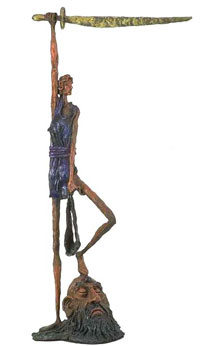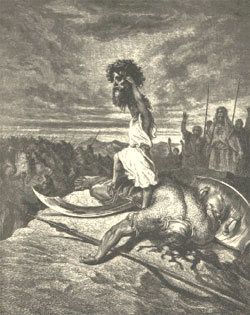
|
"After He Killed Him, He Cut Off His Head:"
David, Goliath, and Sacred Violence
For Sunday June 21, 2009
Lectionary Readings (Revised Common Lectionary, Year B)
1 Samuel 17:1a, 4–11, 19–23, 32–49 or I Samuel 17:57–18:5, 10–16
or Job 38:1–11
Psalm 9:9–20 or Psalm 133 or Psalm 107:1–3, 23–32
2 Corinthians 6:1–13
Mark 4:35–41
 |
Caravaggio (1573-1610). |
Those of us who went to Sunday School as kids remember flannel graph stories about David and Goliath (1 Samuel 17). David was the youngest "little brother" of Jesse's eight sons, relegated to errand boy status, while his older brothers battled the Philistines as manly soldiers. Twice the writer describes David as "only a boy." The narrator pictures David as "ruddy and handsome," hardly the traits of a warrior. When his brothers berated him when he delivered reinforcements to the front lines, he responded plaintively, "Can't I even speak?" (17:29). Saul's armor was so big on him that he couldn't move. Then, of course, there was his famous slingshot that he wielded — whap! — to slay the nine-foot Goliath who had "defied the armies of the living God" (17:26).
The punch line about David and Goliath was something to the effect that God uses insignificant people and unlikely means to accomplish improbable feats. That is certainly true (cf. 1 Corinthians 1:18–25; 3:18–23). But there's one horrifying detail in the story that my Sunday School teacher skipped. David "took hold of the Philistine's sword and drew it from the scabbard. After he killed him, he cut off his head with the sword" (17:51). David then displayed Goliath's head in Jerusalem, brandished it before King Saul, and kept his sword in his tent as a souvenir. By decapitating Goliath, David wanted to "show the whole world that there is a God in Israel. All those gathered here will know that it is not by the sword or spear that the Lord saves; for the battle is the Lord's, and he will give all of you into our hands" (17:46–47).
This story made my mind ping to the decapitation of Nicholas Berg in May 2004, and to numerous other expatriots and Iraqi citizens. In their book The Next Attack (2005), Daniel Benjamin and Steven Simon show how decapitation (still a form of capital punishment in Saudi Arabia) and the signature ear-to-ear throat-slitting by extremists are ways to traumatize and terrorize your enemy. They are "spectacles for ogling," and "participatory events" for those who download replays of the horrific act on the internet. MIT's Technology Review (February 2005) reported that videos of the Berg beheading were downloaded 15 million times, crashing many servers. But decapitation — and this takes us back to David and Goliath — is also a "public sacrament," a "way of making the violence holy," and, write Benjamin and Simon, "an act redolent with the sense of sacrifice and the literal execution of God's law, which to the jihadist means death for infidels and apostates."
 |
Caravaggio (1573-1610). |
Years later, as a poet and song writer David returned to this theme of sacred violence as proof of God's favor. In his acrostic psalm for this week (each verse begins with a successive letter of the Hebrew alphabet), he insists that his cause is righteous, and that his enemies are the enemies of God. He prays for God to rebuke, destroy, blot out, annhilate, and to vanquish his enemies with "endless ruin." As if to erase the least vestige of their humanity, he prays for "even the memory of them [to] perish." He concludes his prayer, "Strike them with terror, O Lord!" (Psalm 9).
How should we read these two texts of terror? You might dismiss the decapitation of Goliath as patriotic fiction or legend, but that takes the easy way out; for some reason, the Hebrews included this story (and other disturbing ones) in their sacred canon. There are also reasonable caveats and qualifications that might mitigate the sacred horror — maybe we have here a case of historical description of something that happened, but that does not mean that God approved of it; primitive cultures back then were more barbaric than ours; divine retribution for truly wicked people and nations is a necessary part of humanity's moral compass and calculus; war and its tragic consequences seem to be an inevitable and inscrutable aspect of the intersection of human history and divine sovereignty; later progress in God's revelation of himself supercedes earlier stories like these; and maybe poetry like Psalm 9 is just angry exagerration or emotional overstatement.
Whether ancient or modern, violence in God's name knows no boundaries. All religions have engaged in sacred terror, including widow burning, child sacrifice, caste systems, mass suicide, female genital mutilation, witch hunts, ritual abuse, ethnic cleansing, suicide bombers, and apartheid — the list is depressingly long. Christians killed thousands in the Crusades and Inquisitions, defended slavery, were complicit in the Holocaust that killed six million Jews, ravaged the Native American peoples, and have murdered abortion doctors and gays.
 |
Phillip Ratner, David and Goliath. |
I'm not sure how to read the Bible's texts of terror, but here are two suggestions.
Whereas the Old Testament contains violence that is divinely sanctioned, at least according to its writers, in the New Testament I can think of only two examples when the followers of Jesus wanted to use violent means for his cause — when James and John wanted to call down fire upon the Samaritans because of their unbelief (Luke 9:51–55), and in the Garden of Gethsemane when his disciples tried to prevent His arrest (Mark 14:47). In both instances Jesus rebuked those who tried to show their allegiance to him through violent means. Instead, he insisted that his Father in heaven causes his sun to shine on both the wicked and the righteous. He told us to love our enemies and to do good to those who persecute us, because in the end the ultimate measure of my love for God is my love for my neighbor.
I can't recall anyone who made this point better than the German pastor Martin Niemoeller (1892–1984), who protested Hitler's anti-semitic measures in person to the fuehrer, was eventually arrested, and then imprisoned for eight years at Sachsenhausen and Dachau (1937–1945). He once confessed, "It took me a long time to learn that God is not the enemy of my enemies. He is not even the enemy of his enemies." When God hates all the same people that you hate, you can be absolutely certain that you have created him in your own image (Lamott).
Second, we should not remain silent when we see attempts to legitimize sacred violence, but instead name it for what it is. We should learn the warning signs that religion has become evil and evil has become religious:
* Fanatical claims of absolute truth. I do not mean the belief that absolute truth exists, but the doubt-free and uncritical confidence that one understands such absolute truth absolutely.
* Blind obedience to totalitarian, charismatic, and authoritarian leaders or their views that undermines moral integrity, personal freedom, individual responsibility, and intellectual inquiry.
* Identifying and rationalizing “end times” scenarios in the name of your religion.
* Justifying religious ends by dubious means.
* Any and all forms of dehumanization, from openly declaring war on your enemy, demonizing those who differ from you, construing your neighbor as an Other, to claiming that God is on your side alone.
* Pressure tactics of coercion, deception, and false advertisement.
* Alienation, isolation and withdrawal from family, friends and society, whether psychologically or literally.
* Exploitation and all forms of unreasonable demands upon one's time, money, resources, family, friendships, sexuality, etc.
Often one or more of these danger signs combine.1
 |
Gustave Dore: David and Goliath. |
We should judge religions by their most authentic examples rather than by their worst corruptions. There is also a difference between evil committed by people who happen to be religious, and evil promoted in the name of religion. Some people overstate the connection between religion and violence, as when Charles Kimball writes that “more evil [has been] perpetrated in the name of religion than by any other institutional force in human history” (a distinction that probably goes to Soviet and Chinese atheism). Sometimes the connection between religion and violence is tenuous, sometimes it is explicit. Sacred terror is almost always complex and bound up with other causes (social, historical, economic, cultural, political, etc). But at the end of the day we must admit that there is far too much violence in the world that is fomented with a specifically religious rationale, motivation, or justification. Christians should commit ourselves to do whatever we can to stop it.
For further reflection:
* What has been your experience of religious violence?
*
Contemplate the powerful words of Martin Niemoeller.
* Can you identify any of the eight warning signs in contemporary American Christianity?
* See Charles Kimball, When Religion Becomes Evil, and Mark Juergensmeyer, Terror in the Mind of God: The Global Rise of Religious Violence.
[1] Some but not all of these are taken from Charles Kimball, When Religion Becomes Evil (San Francisco: Harper and Row, 2002); he focuses on the first five.
Image credits: (1) the Web Museum, Paris; (2) Malaspina Global Portal; (3) The Ratner Museum; and (4) the Korea Computer Mission.





